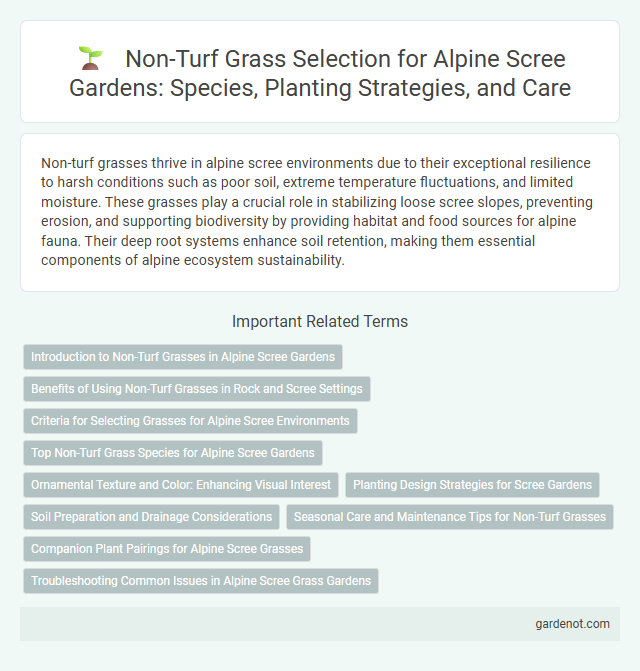Non-turf grasses thrive in alpine scree environments due to their exceptional resilience to harsh conditions such as poor soil, extreme temperature fluctuations, and limited moisture. These grasses play a crucial role in stabilizing loose scree slopes, preventing erosion, and supporting biodiversity by providing habitat and food sources for alpine fauna. Their deep root systems enhance soil retention, making them essential components of alpine ecosystem sustainability.
Introduction to Non-Turf Grasses in Alpine Scree Gardens
Non-turf grasses, such as Festuca and Carex species, thrive in alpine scree gardens due to their adaptability to rocky, well-drained soils and harsh climatic conditions. These grasses contribute to soil stabilization and biodiversity by forming clumps that prevent erosion and provide habitat for alpine insects. Their low-maintenance nature and drought tolerance make them ideal for replicating natural alpine ecosystems in garden settings.
Benefits of Using Non-Turf Grasses in Rock and Scree Settings
Non-turf grasses thrive in alpine scree environments by stabilizing loose soil and reducing erosion on steep, rocky slopes. These grasses require minimal maintenance and water, making them ideal for harsh alpine conditions with poor nutrient availability and extreme weather. Their deep root systems enhance biodiversity and support habitat for specialized alpine wildlife, contributing to ecological balance in scree landscapes.
Criteria for Selecting Grasses for Alpine Scree Environments
Grasses selected for alpine scree environments must demonstrate exceptional drought tolerance, cold resistance, and robust root systems to stabilize loose rocky substrates. Species such as Festuca ovina and Poa alpina thrive due to their adaptability to nutrient-poor soils and ability to withstand extreme temperature fluctuations. Emphasizing low growth habit and seed dispersal efficiency enhances survival in the dynamic, erosion-prone scree habitat.
Top Non-Turf Grass Species for Alpine Scree Gardens
Festuca ovina and Deschampsia cespitosa are top non-turf grass species ideal for alpine scree gardens due to their drought tolerance and ability to thrive in rocky, well-drained soils. Carex firma exhibits excellent resilience to cold temperatures and poor nutrient availability, making it a preferred choice for stabilizing scree slopes. These species contribute to erosion control while enhancing the biodiversity and aesthetic appeal of alpine scree landscapes.
Ornamental Texture and Color: Enhancing Visual Interest
Non-turf grasses thrive in alpine scree environments, offering diverse ornamental textures that contrast sharply with rocky landscapes. Their varying leaf shapes and colors--from silvery blues to deep greens--create layered visual interest and seasonal color shifts. These grasses improve habitat complexity while providing erosion control on steep, unstable scree slopes.
Planting Design Strategies for Scree Gardens
Non-turf grasses such as Carex and Festuca species are ideal for alpine scree gardens due to their drought tolerance and minimal soil requirements. Incorporating these grasses in planting design strategies enhances erosion control by stabilizing loose, rocky substrates while providing texture and movement in the landscape. Strategic placement alongside low-growing alpines and succulents creates a resilient, visually dynamic scree garden that mimics natural high-altitude ecosystems.
Soil Preparation and Drainage Considerations
Soil preparation for non-turf grass in alpine scree environments requires enhancing soil structure to promote root penetration and stability on rocky slopes. Effective drainage is crucial to prevent waterlogging and erosion, often achieved by incorporating coarse materials like gravel to facilitate rapid water runoff. Ensuring proper aeration and moisture balance supports healthy grass establishment in challenging alpine conditions.
Seasonal Care and Maintenance Tips for Non-Turf Grasses
Seasonal care for non-turf grasses in alpine scree environments involves targeted watering during dry periods and minimal fertilization to maintain natural soil balance. Regular monitoring for pests and diseases ensures early intervention, preserving the grasses' resilience against harsh alpine conditions. Pruning dead foliage in early spring promotes healthy new growth and improves overall plant vigor.
Companion Plant Pairings for Alpine Scree Grasses
Non-turf grasses suited for alpine scree environments thrive when paired with companion plants such as saxifrages, sedums, and dwarf conifers, which enhance soil stability and microhabitat diversity. These companion species provide complementary root structures and moisture retention, supporting resilient growth in rocky, well-drained substrates typical of Alpine scree. Optimizing plant pairings improves erosion control and promotes a balanced alpine ecosystem, crucial for sustaining biodiversity at high altitudes.
Troubleshooting Common Issues in Alpine Scree Grass Gardens
Alpine scree gardens with non-turf grasses often face challenges such as poor drainage, leading to root rot in species like Festuca or Carex. Monitoring soil pH and adjusting it to slightly acidic or neutral levels can prevent nutrient deficiencies commonly observed in these hardy grasses. Managing invasive weeds early is crucial to maintain the delicate balance of alpine scree ecosystems and support healthy grass growth.
Non-turf grass Infographic

 gardenot.com
gardenot.com